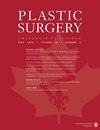使用 BODY-Q 测量青少年妇科整形手术后的生活质量:横断面分析
IF 0.6
4区 医学
Q4 SURGERY
引用次数: 0
摘要
背景:患者报告结果测量法(PROMs)越来越多地被用于征求患者的反馈意见。有关青少年乳头瘤手术后疗效的知识存在空白。本研究使用专门针对身体塑形手术的 PROM 评估青少年患者在阉割手术后的生活质量,并确定与生活质量评分相关的患者和治疗因素。方法邀请2009年5月至2022年11月期间在不列颠哥伦比亚省儿童医院接受西蒙I、IIa或IIb级妇科整形手术治疗的青少年患者填写身体塑形问卷(BODY-Q)胸部满意度和心理功能量表。原始分数经过 Rasch 转换(0-100 分)、取平均值并与常模分数进行比较。从病历中收集体重指数(BMI)、西蒙等级、术后并发症和翻修手术信息,并分析其与 BODY-Q 评分的关联。结果:76 位患者中有 37 位(48.7%)完成了 BODY-Q。完成调查时,参与者的中位年龄为 23.3 岁,中位体重指数为 26.5。从手术到完成调查的中位时间为 7 年。胸部满意度和心理功能量表的中位数分别为 70 分和 71 分,明显高于未受影响男性在相同量表上的标准分(分别为 P = .0004 和 P = .0014)。接受翻修手术与胸部外观满意度明显降低有关 ( P = .045)。结论与年龄和体重指数相似的未受影响男性相比,接受过妇科整形手术的患者对胸部外观和心理功能的满意度更高,这是由 BODY-Q 测量得出的结果。这些结果可能对消除青少年对妇科整形手术的污名化起到重要作用。本文章由计算机程序翻译,如有差异,请以英文原文为准。
Quality of Life Measured Using the BODY-Q After Adolescent Gynecomastia Surgery: A Cross-Sectional Analysis
Background: Patient-reported outcome measures (PROMs) are increasingly used to seek feedback from patients. Knowledge gaps exist regarding outcomes in adolescents postgynecomastia surgery. This study assesses adolescent patients’ quality of life postgynecomastia surgery using a PROM specific for body contouring procedures, and identifies patient and treatment factors associated with quality of life scores. Methods: Adolescent patients undergoing surgical treatment for Simon grades I, IIa, or IIb gynecomastia from May 2009 to November 2022 at British Columbia Children's Hospital were invited to complete the Body Contouring Questionnaire (BODY-Q) Satisfaction with Chest and Psychological Function scales. Raw scores were Rasch transformed (scale 0-100), averaged, and compared to normative scores. Body mass index (BMI), Simon grade, postoperative complication, and revision procedure information were collected from medical charts and analyzed for associations with BODY-Q scores. Results: Thirty-seven of 76 patients (48.7%) completed the BODY-Q. At the time of survey completion, the median age of participants was 23.3 years, and the median BMI was 26.5. The median time from surgery to survey completion was 7 years. Median scores on the Satisfaction with Chest and Psychological Function scales were 70 and 71, respectively, which were significantly higher than normative scores of unaffected males on the same scales ( P = .0004 and P = .0014, respectively). Undergoing a revision procedure was associated with significantly worse satisfaction with chest appearance ( P = .045). Conclusion: Patients who underwent gynecomastia surgery report better satisfaction with chest appearance and psychological function, as measured by the BODY-Q, compared to unaffected males of similar age and BMI. These results may play an important role in destigmatizing gynecomastia surgery for adolescents.
求助全文
通过发布文献求助,成功后即可免费获取论文全文。
去求助
来源期刊

Plastic surgery
Medicine-Surgery
CiteScore
1.70
自引率
0.00%
发文量
73
期刊介绍:
Plastic Surgery (Chirurgie Plastique) is the official journal of the Canadian Society of Plastic Surgeons, the Canadian Society for Aesthetic Plastic Surgery, Group for the Advancement of Microsurgery, and the Canadian Society for Surgery of the Hand. It serves as a major venue for Canadian research, society guidelines, and continuing medical education.
 求助内容:
求助内容: 应助结果提醒方式:
应助结果提醒方式:


